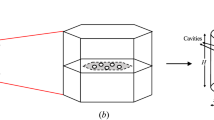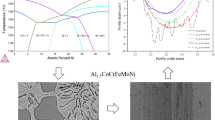Abstract
The presence and change of thermal stresses in solders, which are used for mounting microelectronic packages on PC-boards, will eventually lead to material fatigue. The number of cycles to failure can be predicted from empirical relations of the Coffin–Manson type provided the increments of creep strains and/or energy densities are known, for example, from (rather extensive) FE-simulations. A special problem arises for newly developed solders for which the Coffin–Manson equations are not known yet and need to be established first from a combination of FE and costly reliability experiments. In any case the goal of the industry and research institutions is to replace experiments as much as possible by reliable predictive simulations. However, FE calculations, which are widely used to perform this task, can—as indicated—be rather time-consuming, due to the huge effort involved for component meshing, and due to the various non-linear constitutive equations required for the description of creep in solders and other package materials. In a previous paper (Müller and Hauck in Mech Adv Mater Struct, 15(6):485–489, (2008)) a simple analytical 1D-model was presented that allows computing characteristic damage quantities, such as creep strain and creep energy density, for different solder materials and different temperature profiles in a very efficient manner, provided a creep law is known. In this paper the proposed procedure is validated by comparison with results from detailed FE-simulations.
Similar content being viewed by others
References
Solomon H.D.: Fatigue of 60/40 solder. IEEE Trans. Compon. Hybrids Manuf. Technol. Chmt-9(4), 423–432 (1986)
Zhang X., Ricky Lee S.W., Choi K.-S., Kim Y.-G.: Computational parametric analyzes on the solder joint reliability of bottom leaded plastic (BLP) package. IEEE Trans. Adv. Packag. 25(4), 514–521 (2002)
Ying, M., Chow, S.G., Emigh, R., Punzalan, J.D., Ramakrishna, K.: Design considerations on solder joint reliability of dual row quad flat no-lead packages. In: Proceedings of the 2004 Electronics Packaging Technology Conference, pp. 308–312 (2004)
Spraul, M., Nüchter, W., Möller, A., Wunderle, B., Michel, B.: Reliability of SnPb and SnPb-free flip-chips under different test conditions. In: Proceedings of the EuroSimE, pp. 437–442 (2004)
Dudek, R., Walter, H., Doering, R., Michel, B.: Thermal fatigue modelling for SnAgCu and SnPb solder joints. In: Proceedings of the EuroSimE, pp. 557–564 (2004)
Chen, L., Zhang, Q., Wang, G., Xie, X., Cheng, Z.: The effects of underfill and 1st material models on thermomechanical behaviors of a flip chip package. IEEE Trans. Adv. Packag. 24(1), 17–24, (2001) (cites original Coffin–Manson data from Engelmeier, W.: Fatigue life of leadless chip carrier solder joints during power cycling. IEEE Trans. Compon. Hybrids Manuf. Technol. 9, 423–432 (1986) Solder attachment reliability accelerated testing and result evaluation. Solder Joint Reliab. Theory Appl. p. 568)
Hong, B.Z., Yuan, T.-D.: Integrated flow—thermomechanical and reliability analysis of a densely packed C4/CBGA assembly. In: Proceedings of the InterSociety Conference on Thermal Phenomena, pp. 220–228 (1998) (cites original data from Mukai, M., Kawakami, T., Tabahashi, K., Iwase, N.: Thermal fatigue life prediction of solder joints using SMS analysis. In: IEMT/IMC Proceedings, IEEE, Sonic City, Omiya, Japan, pp. 204–208, April 1997)
Ghorbani H.R., Spelt J.K.: An analytical elasto-creep model of solder joints in leadless chip resistors: part 2—applications in fatigue reliability predictions for SnPb and lead-free solders. IEEE Trans. Adv. Packag. 30(4), 695–704 (2007)
Müller W.H., Hauck T.: Simple methods for the durability assessment of microelectronic solders. Mech. Adv. Mater. Struct. 15(6), 485–489 (2008)
Müller, K., Prikhodovsky, A.: Measurements at NMB
Dudek, R.: Notes of Short Course B. EPTC 2005, Singapore (2005)
Wilke, K.: TMA measurements performed on various lead-free solder as part of the BMBF project LIVE (2006)
Dudek, R.: Personal communication as part of the LIVE project (2007)
Wiese, S., Röllig, M., Müller, M., Rzepka, S., Nocke, K., Luhmann, C., Krämer, F., Meier, K., Wolter, K.-J.: The influence of size and composition on the creep of SnAgCu solder joints. In: Proceedings of the ESTC 2006, Dresden, pp. 912–925 (2006)
Author information
Authors and Affiliations
Corresponding author
Rights and permissions
About this article
Cite this article
Hannach, T., Worrack, H., Müller, W.H. et al. Creep in microelectronic solder joints: finite element simulations versus semi-analytical methods. Arch Appl Mech 79, 605–617 (2009). https://doi.org/10.1007/s00419-008-0292-8
Received:
Accepted:
Published:
Issue Date:
DOI: https://doi.org/10.1007/s00419-008-0292-8




